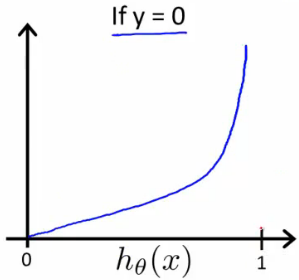Logistic Regression Model
- goal: want
$h_{\theta}(x) \in [0,1]$ $h_{\theta}(x)=g(\theta^Tx)$, where$g(z)=\frac{1}{1+e^{-z}}$(sigmoid function/ logistic function)- interpretations:
$h_{\theta}(x)$= estimated probability that$y=1$on input$x$, that is
$$h(x)=h_{\theta}(x) = \Pr(y=1|x;\theta)$$
prediction: predict
$y=1$if$h_{\theta}(x)\geq 0.5 \Leftrightarrow \theta^Tx\geq 0$Decision Boundary:
$\theta^Tx= 0$Nonlinear Decision Boundary: add complex (i.e. polynomial) terms
Notations: training set
$\{(x^{(i)}, y^{(i)})\}_{i=1}^N$, where
$$ x = \begin{pmatrix}x_0\newline x_1\newline\vdots\newline x_p\end{pmatrix}\in\mathbb{R}^{p+1}, x_0=1,y\in\{0,1\} $$
Logistic Regression Cost/ Loss Function
$$ J(\theta)=\frac{1}{N}\sum_{i=1}^N L\left(h(x^{(i)}),y^{(i)}\right), \text{where} $$
$$ L(h(x), y)=\begin{cases} -\log h(x), &y=1\newline -\log(1-h(x)), &y=0 \end{cases} $$
$$ \Rightarrow L(h(x), y)=-y\log h(x)-(1-y)\log(1-h(x))=-log\left[h(x)^y (1-h(x))^{1-y}\right] $$
- interpretation of cost function:
- if
$h(x)=y$for$y=1$or$0$, then$L(h(x), y)=0$ - if
$y=1$,$L(h(x), y)\rightarrow\infty$as$h(x)\rightarrow 0$ - if
$y=0$,$L(h(x), y)\rightarrow\infty$as$h(x)\rightarrow 1$
- if


- why not quadratic loss?
- To ensure convexity (Left: quadratic loss, Right: logistic loss)
- Maximum Likelihood Estimation
Gradient Descent
$$ \frac{\partial}{\partial\theta_j}J(\theta) = \frac{1}{N} \sum_{i=1}^N \frac{\partial}{\partial\theta_j}L(h(x^{(i)}),y^{(i)}) $$
Let $z = \theta^T x, a=h_{\theta}(x)=sigmoid(z)$, then
$$
\frac{\partial L}{\partial\theta_j}=\frac{\partial L}{\partial a}\frac{\partial a}{\partial z}\frac{\partial z}{\partial\theta_j}\\
\Rightarrow
\frac{\partial L}{\partial a} = -\frac{y}{a}+\frac{1-y}{1-a},\ \ \ \frac{\partial a}{\partial z}=a(1-a), \ \ \ \frac{\partial z}{\partial\theta_j}=x_j\\
\Rightarrow \frac{\partial L}{\partial\theta_j}=(a-y)x_j=(h(x)-y)x_j
$$
Algorithm:
repeat{
$\theta_j \leftarrow \theta_j -\alpha\frac{\partial}{\partial \theta_j}J(\mathbf{\theta})=\theta_j -\alpha\frac{1}{N}\sum _{i=1}^N \left(h(x^{(i)}) - y^{(i)}\right)x^{(i)}_j$} (simultaneously update for
$j=0,1,...,p$)
$\alpha$: learning rate (step size)
Vectorization
$$ \theta \leftarrow \theta-\frac{\alpha}{N} X^T (h(X)-y) $$
def sigmoid(u):
return 1/(1 + np.exp(-u))
# X: design matrix, N*(p+1)
# Y: N*1
# theta: (p+1)*1
# compute hypothesis
h = sigmoid(np.dot(theta.T, X))
# compute cost
J = - np.mean(np.log(h) * Y + np.log(1-h) * (1-Y))
# compute descent
N = X.shape[0]
dtheta = np.dot(X.T, h - Y)/N
# update params
theta -= learning_rate*dtheta
Advanced Optimization Methods
- Algorithms:
- conjugate gradient
- BFGS
- L-BFGS
- Advantages:
- no need to manually pick learning rate (step size)
$\alpha$ - often faster than gradient descent
- no need to manually pick learning rate (step size)
- Disadvantages:
- more complex
Multiclass Classification: One-vs-All
$K$classes, fit$K$classifiers: $$ h^{(k)}_{\theta}(x)=\Pr(y=i|x;\theta),\ \ \ \ k=1,2,\ldots,K. $$
$$ x \rightarrow \text{class } k^*=\arg\max_{k=1,2\ldots,K} h^{(k)}_{\theta}(x) $$
Solving the Problem of Overfitting
- underfitting: high bias
- overfitting: high variance
- address overfitting:
- reduce # of features:
- manually select
- model selection algorithm
- regularization:
- keep all the features, but reduce the magnitude of parameters
$\theta_j$ - regularization works well when we have a lot of slightly useful features
- keep all the features, but reduce the magnitude of parameters
- reduce # of features:
- regularization: small values for parameters
- simpler hypothesis
- less prone to overfitting
Regularized Linear Regression
$$ J(\theta)=\frac{1}{2N}\left(\sum_{i=1}^N (h_\theta(x^{(i)}) - y^{(i)})^2 + \lambda\sum_{j=1}^p \theta_j^2\right) $$
- regularization term:
$\lambda\sum_{j=1}^p \theta_j^2$ - regularization parameter:
$\lambda\geq 0$- Using the above cost function with the extra summation, we can smooth the output of our hypothesis function to reduce overfitting.
- If
$\lambda$is chosen to be too large, it may smooth out the function too much and cause underfitting.
Gradient Descent
Algorithm:
repeat{
$\theta_0 \leftarrow \theta_0 -\alpha\frac{\partial}{\partial \theta_0}J(\mathbf{\theta})=\theta_j -\alpha\frac{1}{N}\sum _{i=1}^N \left(h(x^{(i)}) - y^{(i)}\right)$
$\theta_j \leftarrow \theta_j -\alpha\frac{\partial}{\partial \theta_j}J(\mathbf{\theta})=\theta_j -\frac{\alpha}{N}\left[\sum _{i=1}^N \left(h(x^{(i)}) - y^{(i)}\right)x^{(i)}_j+\lambda\theta_j\right],\ \ \ \ j=1,...,p$} (simultaneously update)
$\alpha$: learning rate (step size)
$$\theta_j \leftarrow \left(1-\alpha\frac{\lambda}{N}\right)\theta_j -\alpha\frac{1}{N}\sum _{i=1}^N \left(h(x^{(i)}) - y^{(i)}\right)x^{(i)}_j\ \ \ \ j=1,…,p$$
$\left(1-\alpha\frac{\lambda}{N}\right) <1$, shrinking
Normal Equation
$$
2NJ(\theta) =(X\theta-y)^T(X\theta-y) +\lambda \theta^TH\theta, \ \ \ \text{where}\\
H = \begin{pmatrix}
0 &0 &\cdots &0\newline
0 &1 &\cdots &0\newline
\vdots &\vdots &\ddots &\vdots\newline
0 &0 &\cdots &1
\end{pmatrix}_{(p+1)\times(p+1)}
$$
$$ \Rightarrow N\frac{\partial J}{\partial\theta}=X^TX\theta-X^Ty+\lambda H\theta $$
$$ \Rightarrow \theta^* = (X^TX +\lambda H)^{-1}X^Ty $$
- if
$\lambda>0$,$X^TX+\lambda H$is invertible even when$p>N$.
Regularized Logistic Regression
$$ J(\theta)=-\frac{1}{N}\sum_{i=1}^N\left[y^{(i)}\log h(x^{(i)}) + (1-y^{(i)})\log\left (1-h(x^{(i)})\right)\right] + \frac{\lambda}{2N}\sum_{j=1}^p \theta_j^2 $$
Algorithm:
repeat{
$\theta_0 \leftarrow \theta_0 -\alpha\frac{\partial}{\partial \theta_0}J(\mathbf{\theta})=\theta_j -\alpha\frac{1}{N}\sum _{i=1}^N \left(h(x^{(i)}) - y^{(i)}\right)$
$\theta_j \leftarrow \theta_j -\alpha\frac{\partial}{\partial \theta_j}J(\mathbf{\theta})=\theta_j -\frac{\alpha}{N}\left[\sum _{i=1}^N \left(h(x^{(i)}) - y^{(i)}\right)x^{(i)}_j+\lambda\theta_j\right],\ \ \ \ j=1,...,p$} (simultaneously update)
$\alpha$: learning rate (step size)
$$ \theta_j \leftarrow \left(1-\alpha\frac{\lambda}{N}\right)\theta_j -\alpha\frac{1}{N}\sum_{i=1}^N \left(h(x^{(i)}) - y^{(i)}\right)x^{(i)}_j,\ \ \ \ j=1,…,p $$
Code in Python
- Logistic Regression: jupyter notebook
- Regularized Logistic Regression: jupyter notebook
- Multiclass Classification with Regularized Logistic Regression-Handwritten Digits Recognition: jupyter notebook